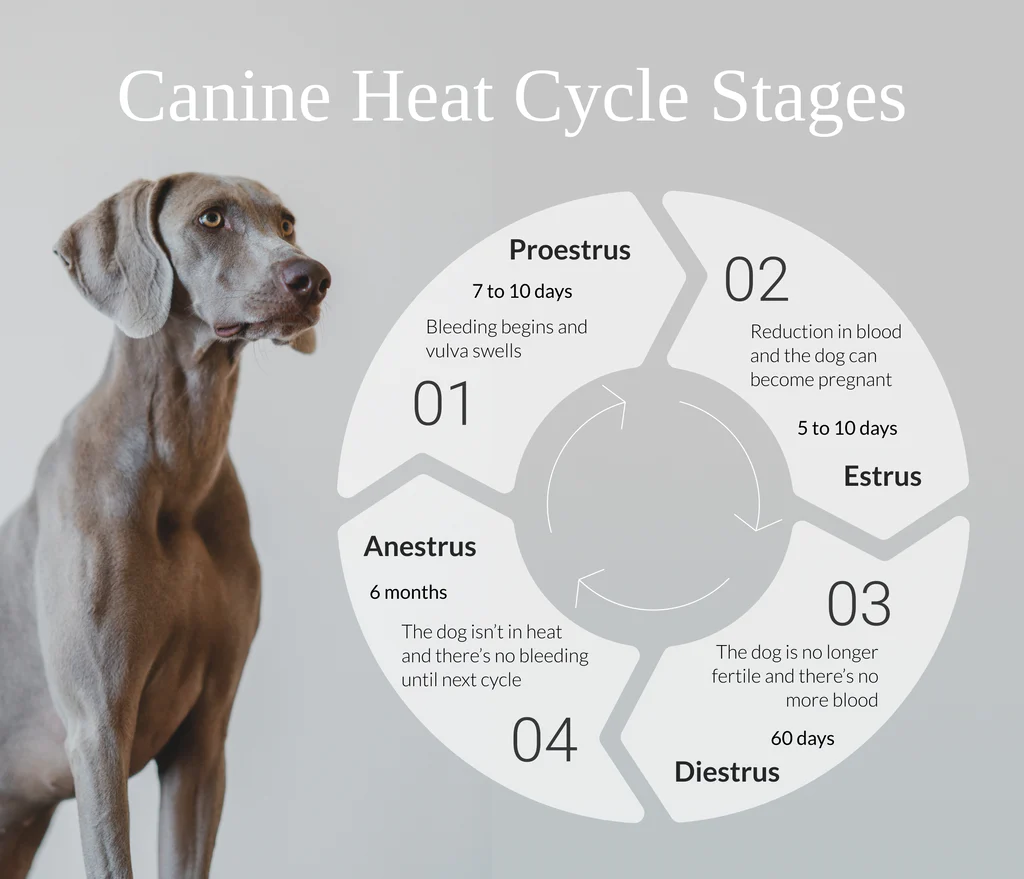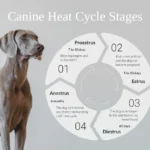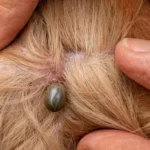As a responsible dog owner, it is essential to have a comprehensive understanding of your furry friend’s health and well-being. One crucial aspect of a female dog’s life is her reproductive cycle, commonly referred to as “dog periods” or the estrus cycle. This article aims to provide you with valuable insights into this natural process and the significance of managing dog periods for the overall health and happiness of your beloved pet.


The Canine Estrus Cycle
The canine estrus cycle, also known as the dog’s heat cycle, is a complex biological process that occurs in unspayed female dogs. This reproductive cycle is crucial for the dog’s ability to reproduce. The estrus cycle is divided into several distinct phases, each serving a specific purpose.
During the estrus cycle, the ovaries release eggs, and the dog’s body undergoes hormonal changes to prepare for potential pregnancy. The duration of the estrus cycle varies between individual dogs, but it generally lasts about three weeks.
Throughout the estrus cycle, female dogs exhibit various physical and behavioral changes that signal their fertility. As responsible pet owners, understanding these phases is essential for proper care and management.
Age and Frequency of Dog Periods
At what age do female dogs experience their first period?
The age at which a female dog experiences her first period, or the onset of puberty, varies among breeds and individual dogs. Typically, small dog breeds reach sexual maturity earlier than larger breeds. In most cases, female dogs experience their first heat cycle between six to twelve months of age.
How often do dogs go into heat (estrus cycle frequency)?
The frequency of dog periods depends on several factors, including the breed, age, and overall health of the dog. On average, dogs go into heat every six to eight months, but this can vary. Some dogs may have irregular cycles, while others may experience seasonal variations.
Various factors can influence the frequency of dog periods, such as changes in daylight, temperature, and the presence of other female dogs in the vicinity.
Do Female Dogs Have Periods Every Month?
Yes, female dogs do experience periods, which are known as the estrus cycle or heat cycle. However, unlike human females who have monthly menstrual cycles, female dogs’ estrus cycles occur less frequently. The estrus cycle in dogs typically happens every six to eight months, but it can vary depending on factors such as breed, age, and individual health. During this cycle, the female dog goes through various hormonal changes and is potentially fertile.
Do Female Dogs Have Periods After Being Spayed?
No, female dogs do not have periods after being spayed. Spaying is a surgical procedure in which the ovaries and uterus are removed, rendering the dog unable to reproduce. After spaying, the dog’s hormonal changes related to the estrus cycle cease, and she will no longer experience heat periods. Spaying is often recommended by veterinarians as a means of preventing unwanted litters and providing health benefits to the dog.
What Happens During a Female Dog’s Period?
During a female dog’s period or estrus cycle, her body goes through several phases. The cycle generally consists of four stages:
- Proestrus: This is the initial phase, lasting about 7 to 10 days, during which the female dog’s estrogen levels rise. Signs of proestrus include vaginal swelling and a bloody discharge. However, the female is not yet receptive to mating at this stage.
- Estrus: The estrus phase lasts approximately 5 to 9 days and is the fertile period. The vaginal discharge becomes lighter in color, indicating that the female is receptive to mating. During this phase, she may actively seek the attention of male dogs.
- Diestrus: After estrus, the female enters diestrus, a non-receptive phase that lasts around 60 to 90 days if she does not conceive. Hormonal levels return to normal, and mating is not possible during this time.
- Anestrus: The final phase is anestrus, a resting period that lasts for about 4 to 5 months before the next estrus cycle begins.
What Do You Do When Your Dog Gets Her Period?
When your female dog is in heat or experiencing her period, it is essential to provide her with extra care and attention. During this time, she may display changes in behavior, such as increased restlessness and seeking the attention of male dogs. To prevent unwanted pregnancies, it is crucial to keep her away from intact male dogs.
You can also take the following precautions to ensure her well-being:
- Keep her on a leash during walks to prevent unwanted mating encounters.
- Provide her with a quiet and comfortable space indoors to minimize stress.
- Keep her surroundings clean and hygienic, as the bloody discharge can attract male dogs.
If you have no intentions of breeding your dog, you may want to consider spaying her. Spaying not only prevents pregnancies but also reduces the risk of certain health issues.
Understanding the Fertile Period within the Estrus Cycle
The estrus cycle, also referred to as the heat cycle, is a critical aspect of a female dog’s reproductive life. Understanding the different phases of the estrus cycle is essential for successful breeding. The cycle typically consists of four stages:
- Proestrus: This initial phase lasts about 7 to 10 days and is characterized by a bloody vaginal discharge. During proestrus, the female is not yet receptive to mating.
- Estrus: The estrus phase, lasting approximately 5 to 9 days, is when the female is fertile and receptive to mating. The discharge becomes lighter in color, indicating the optimal time for breeding.
- Diestrus: Following estrus, the female enters diestrus, a non-receptive phase that lasts around 60 to 90 days if she does not conceive. Hormonal levels return to normal, and mating is not possible during this time.
- Anestrus: The final phase is anestrus, a resting period that lasts for about 4 to 5 months before the next estrus cycle begins.
Risks and Responsibilities of Dog Breeding During Heat
Breeding dogs during their heat cycle comes with significant responsibilities and potential risks. Breeding should be undertaken with thorough knowledge of the breed, genetics, and potential health issues. It is crucial to ensure both the male and female dogs are in optimal health and free from hereditary disorders.
Responsible dog breeding requires careful consideration of the following:
- Genetic Health: Breeding should aim to improve the breed and reduce the risk of passing on genetic health issues. Genetic testing and screening are essential to ensure the well-being of the offspring.
- Emotional Well-being: The breeding process can be physically and emotionally taxing for the female dog. As a responsible breeder, providing proper care and support during pregnancy and whelping is vital.
- Finding Suitable Homes: Responsible breeders ensure that the puppies find loving and caring homes, and they are willing to take back any puppies that can no longer be cared for.
Alternatives to Breeding for Dog Owners
While breeding may be an exciting prospect for some dog owners, it is essential to recognize that it is not the only option. There are alternatives that dog owners can consider to prevent accidental breeding and unwanted pregnancies.
One such alternative is spaying and neutering. Spaying (for females) and neutering (for males) involve surgical procedures that make the dog incapable of reproducing. Spaying not only prevents unwanted pregnancies but also reduces the risk of certain health issues, such as mammary tumors and uterine infections.
Additionally, pet owners can explore temporary contraceptive methods with their veterinarian. These methods can help manage the female dog’s fertility without committing to breeding.
Managing Unwanted Pregnancy: Options and Responsibility
Unwanted pregnancy in dogs can lead to numerous challenges and complications, making it essential for dog owners to be proactive in preventing such situations. In this section, we will explore the importance of spaying and neutering, the risks of accidental breeding, and the available options for preventing pregnancy.
A. Importance of Spaying and Neutering to Prevent Unwanted Pregnancies
Spaying and neutering are surgical procedures that permanently sterilize female and male dogs, respectively. Spaying involves the removal of the ovaries and uterus, while neutering entails the removal of the testicles. These procedures effectively prevent the ability of dogs to reproduce.
Spaying and neutering offer several benefits, including:
- Prevention of Unwanted Pregnancies: Spaying and neutering ensure that your dog cannot reproduce, significantly reducing the risk of accidental pregnancies and unwanted litters.
- Health Benefits: Spaying and neutering can lower the risk of certain health issues in both male and female dogs. For females, it eliminates the risk of uterine infections and reduces the chance of mammary tumors. For males, it can prevent testicular cancer and reduce aggressive behavior.
- Behavioral Improvements: Neutering male dogs can lead to decreased roaming and territorial behaviors, making them less likely to escape and search for mates.
- Population Control: By spaying and neutering pets, we contribute to controlling the pet population, reducing the number of homeless and abandoned animals.
B. Risks of Accidental Breeding and Its Consequences
Accidental breeding can occur when intact male and female dogs are allowed to interact unsupervised during the female’s fertile period. Such incidents can have several consequences, including:
- Unplanned Litters: Accidental breeding can lead to unexpected and unplanned litters, placing a strain on the dog owner’s resources and the local animal shelters.
- Health Risks: Pregnancy and whelping can pose health risks to the female dog, especially if she is not adequately cared for during the gestation and birthing process.
- Behavioral Challenges: Unplanned litters may result in behavioral challenges for the mother and her puppies, particularly if proper socialization and training are lacking.
- Overpopulation: Accidental breeding contributes to pet overpopulation, resulting in an increased number of dogs in shelters and potential euthanasia for those that cannot find homes.
C. Available Options for Preventing Pregnancy
Apart from spaying and neutering, there are other options available for preventing pregnancy in female dogs:
- Hormonal Contraceptives: Hormonal contraceptives, such as birth control pills or injections, can temporarily prevent female dogs from going into heat. However, these methods should only be used under the guidance of a veterinarian, as they may have side effects.
- Intrauterine Devices: A veterinarian can insert an intrauterine device (IUD) into the female dog’s uterus, providing temporary contraception.
- Behavioral Management: During the female dog’s heat cycle, vigilant supervision and separation from intact males can prevent accidental breeding.
Conclusion
In conclusion, understanding and managing dog periods are vital aspects of responsible pet ownership. The canine estrus cycle, commonly known as dog periods, plays a significant role in a female dog’s reproductive life. Being aware of the different phases of the estrus cycle and the signs and symptoms during each phase empowers dog owners to provide the best care for their furry companions.
By knowing when their female dogs are fertile, pet owners can take appropriate precautions to prevent unwanted pregnancies. Spaying and neutering are effective and permanent solutions to avoid accidental breeding and contribute to controlling the pet population.
Frequently Asked Questions About Dog Periods
How long do female dogs bleed?
Female dogs typically bleed during their heat cycle for about 2 to 4 weeks. The duration can vary from dog to dog.
How long does a dog’s first heat last?
A dog’s first heat, also known as the first estrus cycle, usually lasts around 2 to 3 weeks. However, it can be shorter or longer depending on the individual dog.
How long does a dog’s season last?
A dog’s season, which refers to their heat cycle, lasts for an average of 3 weeks. Again, the duration can vary between individual dogs.
How can I help my dog in heat?
You can help your dog during her heat cycle by keeping her indoors and away from intact male dogs to avoid unwanted pregnancies. Providing a comfortable and quiet space for her can also help her feel more at ease during this time. If you have any concerns or notice unusual behavior, consult your veterinarian for guidance and support.









